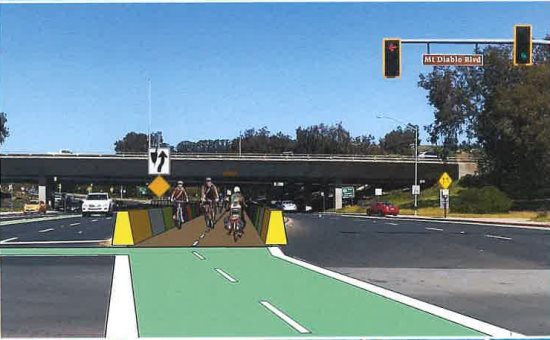
| ||||||
According to a presentation by community member Eric Law at the May 10 Lafayette City Council meeting, there have been five fatal accidents involving cyclists and pedestrians between 2014 and 2021, with 15 bike and 10 pedestrian collisions and 21 injuries reported in Lafayette.
Law discussed a potential project involving building a multi-use protected pathway down the center of Pleasant Hill Road between Mt. Diablo Boulevard and Deer Hill Road/Stanley Boulevard. The pathway, according to a staff report prepared by Director of Engineering and Public Works Mike Moran, would eliminate the need for pedestrians and bicyclists to cross Hwy 24 on- and off-ramps, and connect Pleasant Hill Road to the East Bay Regional Park District's Lafayette-Moraga Regional Trail.
The Safe Route to Acalanes High School Project, which is sponsored by Sustainable Lafayette, has already been viewed by Caltrans and the Contra Costa Transportation Authority and would have an estimated cost of $3.1 million. The purpose of the presentation was to solidify the council's support for the proposed project, so Law's group can start fundraising, and to consider the feasibility to fund the project and incorporate into a future city capital improvement plan.
"Once we get the design money raised, then we'll start the design process," Law said. "Once we have that design then we can go out for construction bids, and that's when we can nail down the cost of the project. Our goal is during the design phase we can raise money for construction."
Moran said the city would have to oversee the design and since it's going through Caltrans, it could involve 9-12 months of review time and they need 100% plans before the review. Moran said he could see this being a multiple meeting process, if approved, involving community stakeholders.
Mayor Susan Candell asked that risk assessments are done as part of the process. "We may lose some bike lanes, we may lose parking . and it seems this will be worse for cars in the a.m.," she said. She asked that as the project moves forward they consider outlining concrete risks and try to mitigate as many of those as possible to gain public support.
Council Member Cam Burks said, "We have the ultimate responsibility as elected leaders to put something like this before a lot of other things. I'm not only strongly for this project, but I'm excited about it. We're not making a decision tonight to spend $3 million or to spend any money; we're talking about evaluating the feasibility to fund the proposed project perhaps through grants, perhaps through grant money, perhaps through fundraising through Eric, and incorporate it into a future capital city improvement program. This should have been done a long time ago."
Vice Mayor Teresa Gerringer agreed 100%. "Obviously there are things that will have to be worked out," she said. "Staff has already shown a commitment to the project to at least analyzing it and understanding it. Currently it's an in-kind piece of the commitment. We have an opportunity to support [the project] and to move it forward."
The council voted unanimously to support the proposed project, and city manager Niroop Srivatsa said she would draft a letter for the mayor to send to Assemblymember Rebecca Bauer-Kahan regarding a potential $238,000 in state funding that could cover design and environmental costs.
To view Law's presentation, visit www.lovelafayette.org/city-hall/city-council/city-council-meetings and click on Item 5B in the agenda.
Reach the reporter at:
